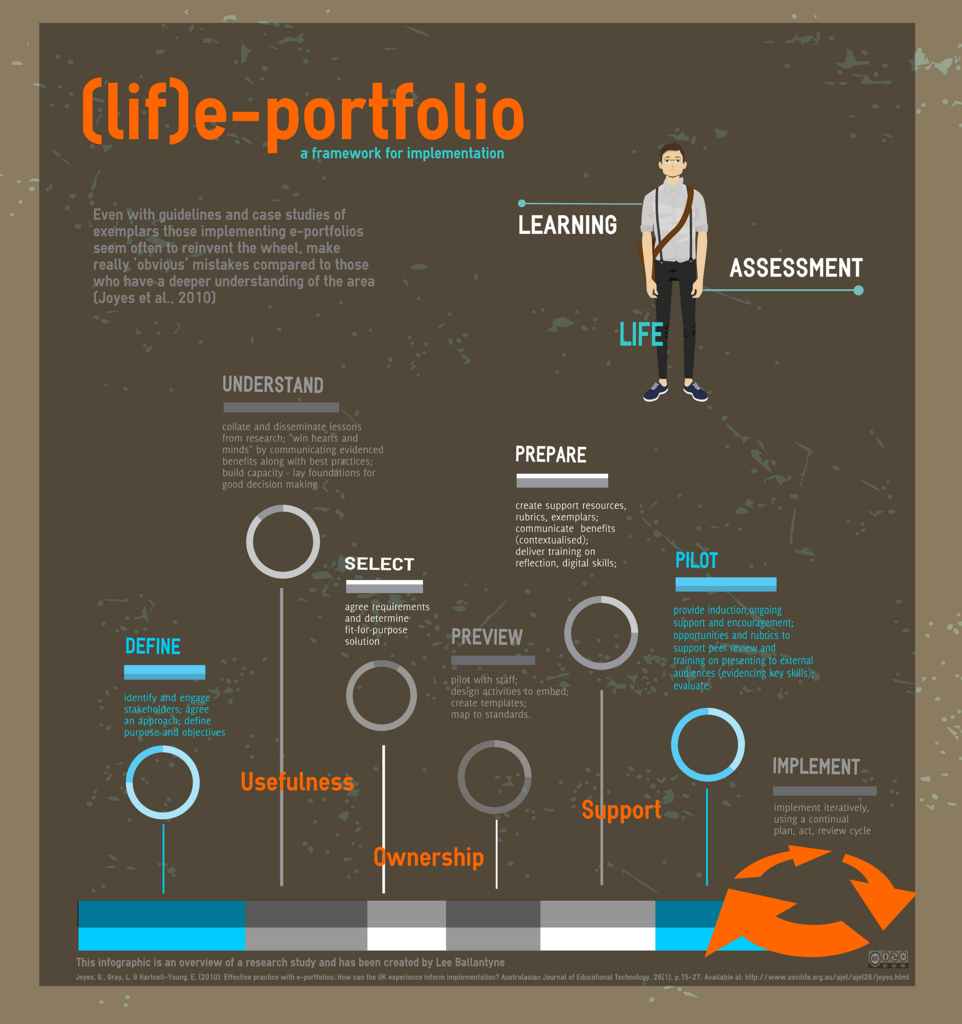As I am a highly visual learner, I've selected two very interesting videos on the topic.
"It's an easily accessible online area where you store all you think is important to your career development."
"They serve as a student's professional digital footprint showcasing a combination of student's work in different formats over a period of time."
A key word mentioned in this last video is REFLECTION. I'm a great fan of e-portfolios myself as it can help learners reflect about their own learning and it's EVIDENCE of what students have learned.
In my opinion, the use of e-portfolios is one of the best ways to evaluate student's progress as well.
In order to help me understand more about e-portfolios, I've also read some articles about their use in education.
An article I really enjoyed reading was
"Portfolios to Webfolios and Beyond: Levels of Maturation" written in 2004 by Douglas Love, Paul Gathercoal and Gerry McKean. In the article, the authors describe different levels of maturation when adopting e-portfolios as an educational tool. The image bellow taken from the article is the taxonomy developed by them.
They also make a distinction between e-portfolios and webfolios.

Portfolios to Webfolios and Beyond: Levels of Maturation (EDUCAUSE Quarterly) | EDUCAUSE.edu via kwout
Another visual resource which I found very useful was the infographic below taken from the blog post http://www.pontydysgu.org/2013/02/issues-in-developing-and-implementing-e-portfolios/ . The blog post mentions the original article which inspired the infographic in which a dichotomy is brought forth: e-portfolios for LEARNING X e-portfolios for ASSESSMENT.
Diagramme: @lee74 (some rights reserved) http://www.flickr.com/photos/lee8/7164889790/
I've been teaching online since 2009 and I've used different tools to have my students create digital portfolios. First, I had my students use BLOGGER for their blog-portfolios. Then, for many years I opted for the POSTEROUS platform which was very easy to use as you could post by sending e-mails. However, unfortunately, Posterous has closed down and if you haven't exported it to another platform, bad luck, the blogs are gone. This year, a few weeks before I started a new online course, I had to rush to find another alternative to Posterous and I ended up choosing TUMBLR, for its ease in publishing different media and its popularity. A drawback I found was that you can't easily leave and receive comments in TUMBLR so that would limit the type of communication I wanted.
I myself made use of a platform to create my own learning portfolio for one of the subjects I took at UFU, Universidade Federal de Uberlândia, while doing my M.A. in Linguistic Studies. We were free to choose what format of portfolio we created, either paper of digital and my choice was a wiki at WIKISPACES. My first doubt at the beginning of the semester was what to include in my digital portfolio for that specific subject at university. I decided to keep adding everything which I thought would be EVIDENCE of what I had been learning.
Next semester, I'm moderating a new group for the CULTURA EDTECH online course and my choice for the webfolios is WEEBLY. It's super easy to create your Weebly blog / portfolio. I liked the way you can drag and drop elements into the editing dashboard and create your blog posts. Apart from being able to publish at the website, you can also download the weebly app and post on the go.
But these are not the only platforms we can use to create digital portfolios, there are many others.
These are some of the blog posts I've curated on tools to create portfolios:
If you still wish to learn more about the topic, another great resource is this PREZI presentation















4 comments:
how interesting! Congratulations on your research. I am starting to deal with e-portfolios and this article was very useful indeed.Thanks a million.Ana Claudia from Argentina
Thanks for your comment, Ana Claudia.
I've just tried a weebly site but probably won't be using it myself unless I can find a really easy way to get audio files on it. You need a Pro account to upload audio and larger then 10MB files in general.
There's probably a way to embed ipadio recordings manually, but with WordPress this can be set up automatically.
Some people on Edmodo are talking about Evernote and I'm still having another look at it. I was concerned about the limit for free accounts (Free: Upload up to 60 MB of data each month, with unlimited storage) but am coming round to thinking that would probably be enough for each student.
At the moment it is probably ipadio for audio feeding into WordPress or possibly Evernote, which has a fascinating dictate feature which I long to try with students.
Thanks for the post which I have enjoyed but haven't followed up all the links yet.
Thank you so much for your comment, Chris. I'm really glad you enjoyed it. As to adding audio to Weebly, what you can do is record the audio at a site which can host the audio (Audioboo or Croak.it), grab the embed code and then post it at weebly. It's quite simple. I've just tested here http://anamariamenezes.weebly.com/1/post/2013/08/embedding-an-audio-file-to-weebly.html
If you need any assistance, let me know and I can try. :)
You can also host larger documents at scribd.com, grab the embed code and post at weebly too.
Post a Comment